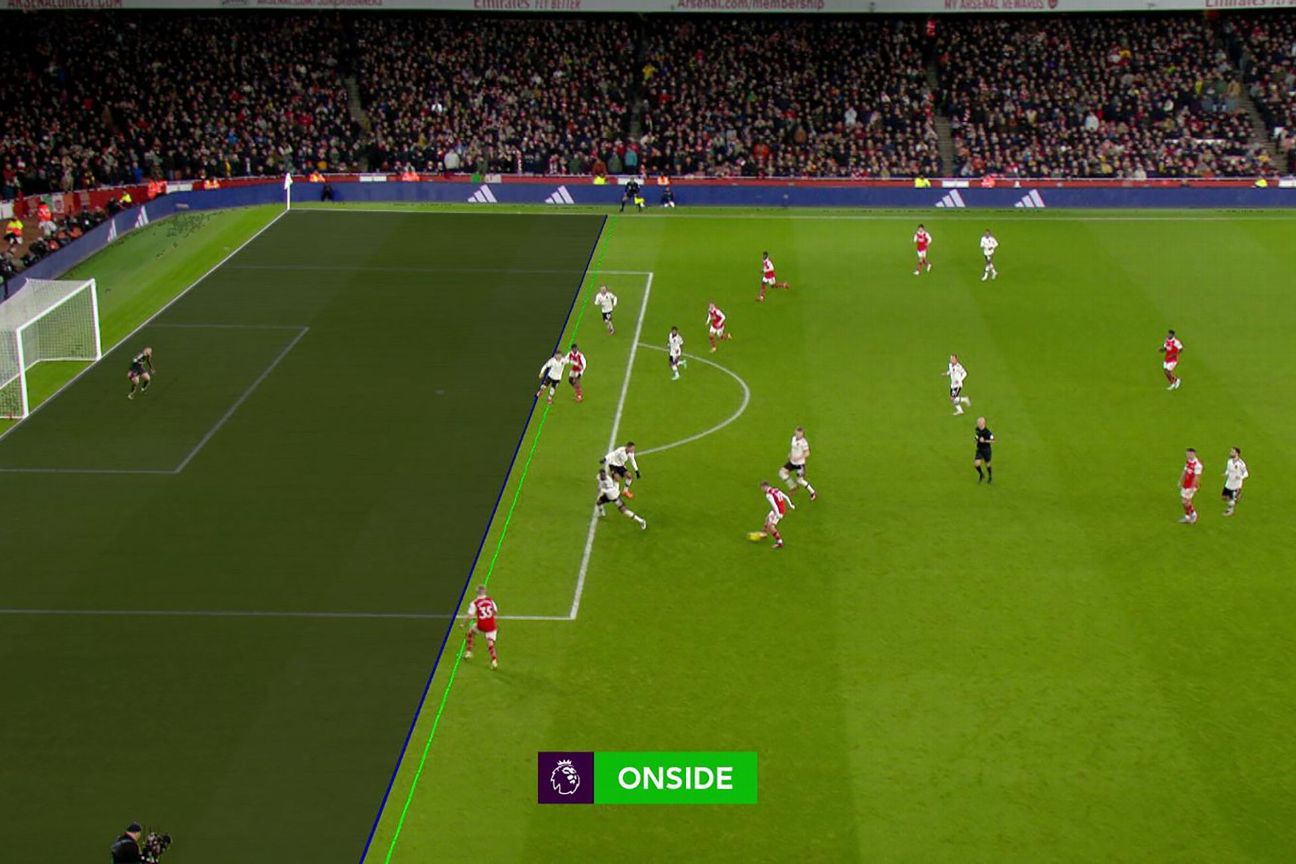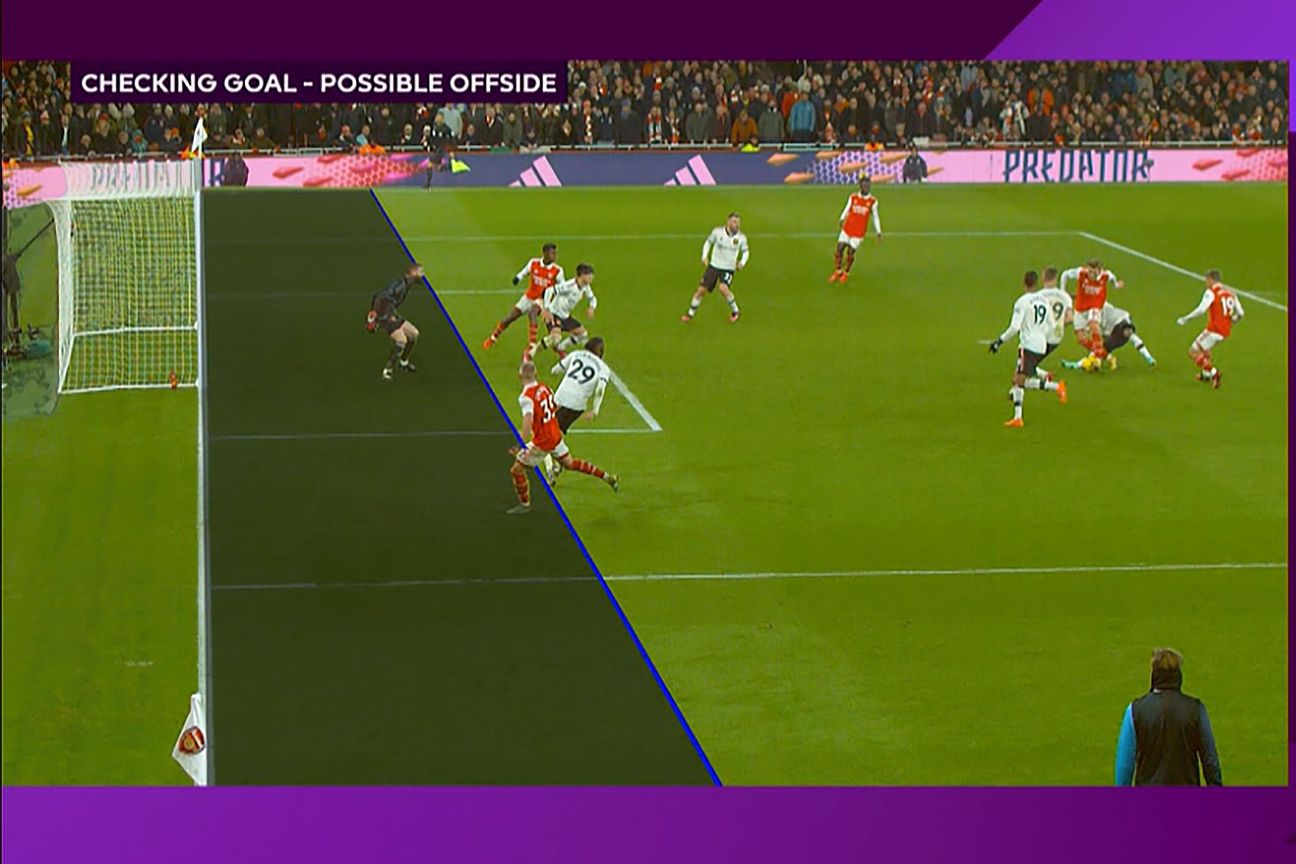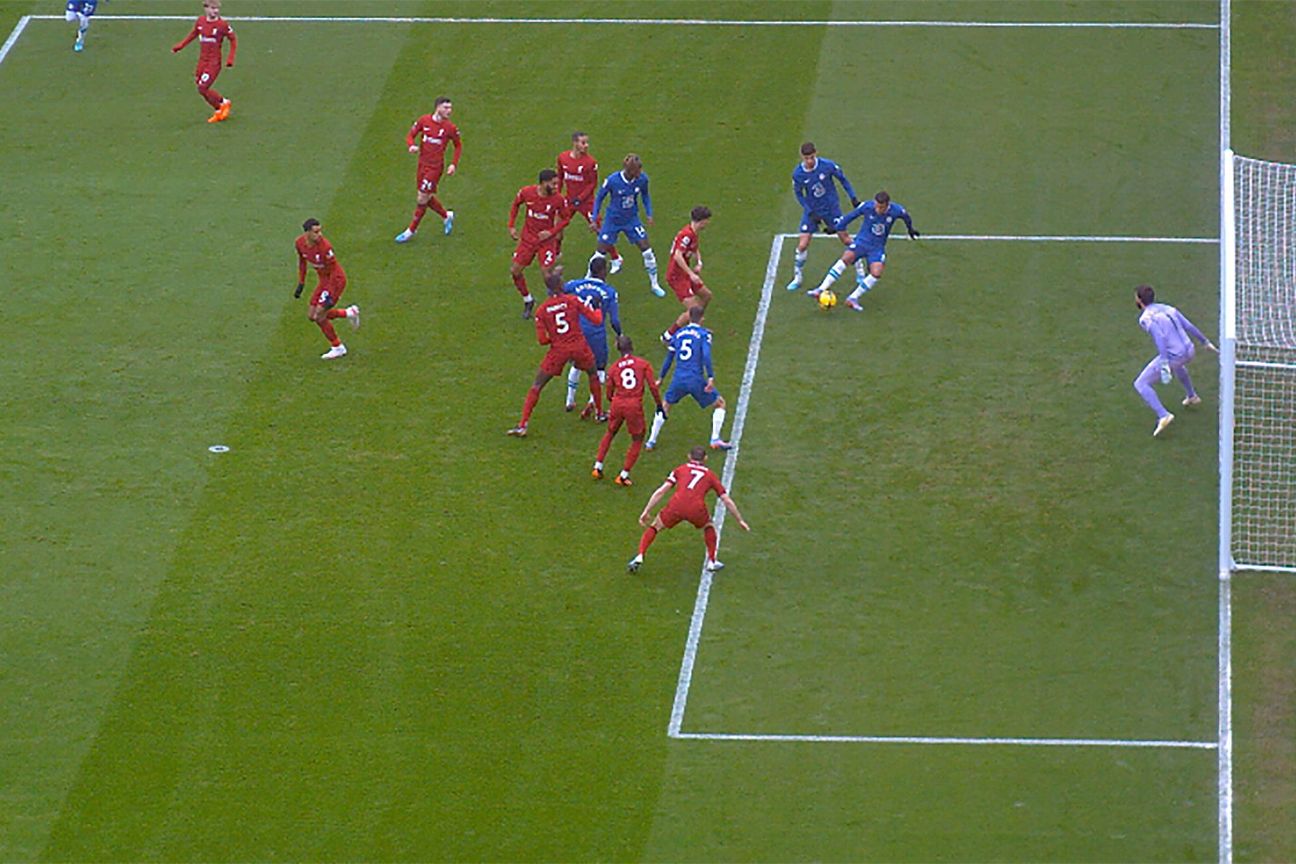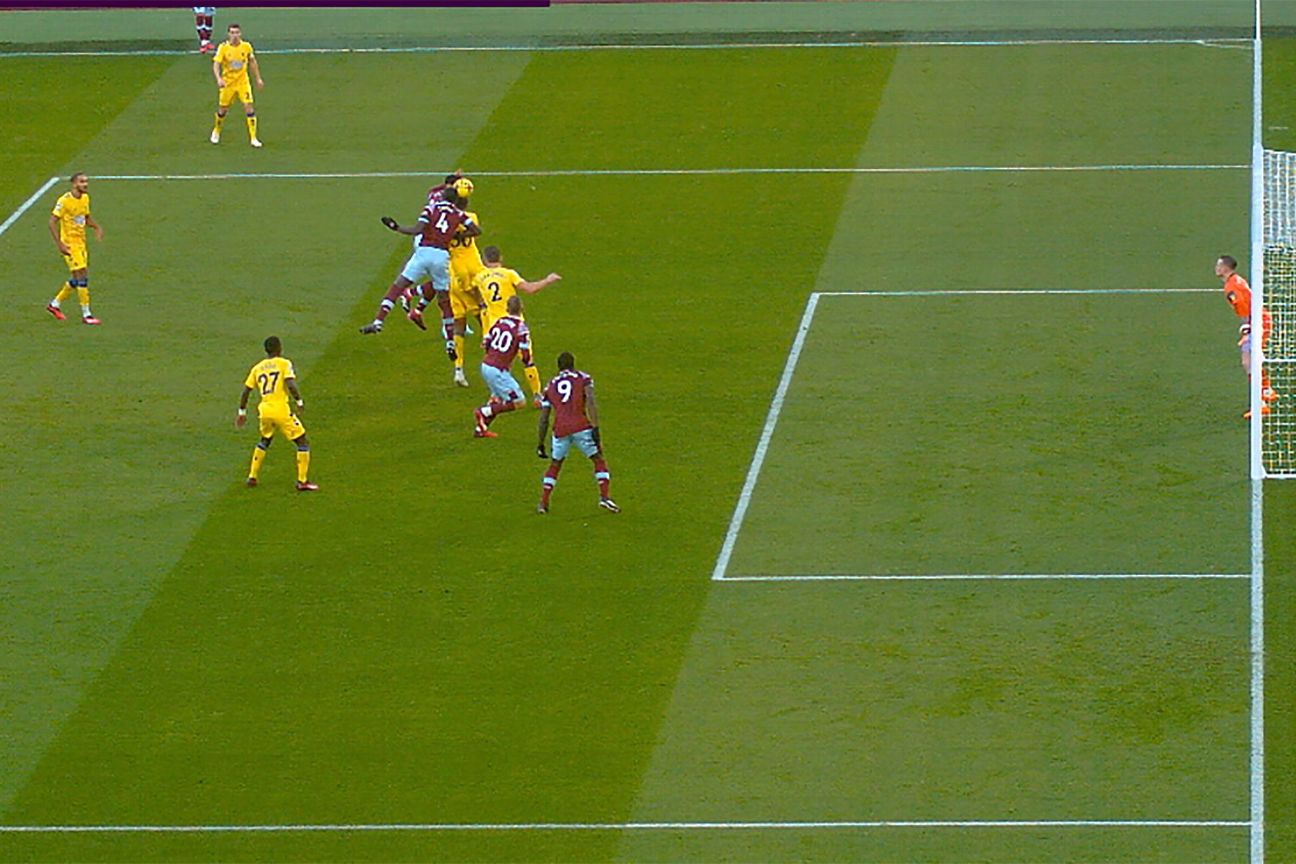Video assistant referee causes controversy every week in the Premier League, but how are decisions made, and are they correct?
After each weekend we take a look at the major incidents, to examine and explain the process in terms of VAR protocol and the Laws of the Game.
- How VAR decisions affected every Prem club in 2022-23
- VAR in the Premier League: Ultimate guide
JUMP TO: Arsenal 3-2 Man United | Leicester 2-2 Brighton | Liverpool 0-0 Chelsea | Southampton 0-1 Villa | West Ham 2-0 Everton | Palace 0-0 Newcastle
Manchester City 3-0 Wolverhampton Wanderers
Possible penalty: Foul by Collins on Grealish
What happened: In the 42nd minute, Jack Grealish was inside the area and moved the ball past Nathan Collins. He was caught on the calf by the Wolverhampton Wanderers player, but referee David Coote ignored the England international's claims for a penalty and gave a goal kick.
VAR decision: No penalty.
VAR review: This all comes back to something discussed many times -- the exaggerated fall that doesn't match the level of contact in the challenge. If Coote gives a penalty, there's no chance it gets overturned (more on that in a moment.) But Grealish goes to ground in a manner so theatrical that the VAR, Darren England, will always take it into account.
In the summer of 2021, the Premier League released a number of video examples of players going to ground in a way that didn't match the contact from the defensive player and thus should not be a penalty. This, coincidentally, included a Manchester City example against Wolves, when Riyad Mahrez was awarded a VAR penalty after contact on the top of the foot from Leander Dendoncker and the Algeria international went down in an exaggerated way.
Contact alone is not enough; that contact must have a consequence in causing the opponent to go to ground. If an attacker uses the contact to try to win a penalty, that will be taken into account by the VAR.
Was there contact on Grealish by Collins? Yes. Did that level of contact cause him to fall as he did? Probably not. And that's why the VAR won't step in to advise a penalty, even if many think it should have been a spot kick.
There will be many occasions when fans and pundits believe there has been a clear VAR error not to give a penalty but in actual fact it's deemed correct in protocol. Take Arsenal's claims for a penalty against Newcastle United. Most believed the Gunners were denied a clear spot kick when Gabriel had his shirt pulled back by Dan Burn. The VAR said no penalty, and the independent assessment panel agreed.
Possible penalty overturn: Foul by Neves on Gundogan
What happened: City were awarded a penalty in the 49th minute when Ilkay Gundogan went down in the area when running in front of Ruben Neves. Referee Coote immediately pointed to the penalty spot.
VAR decision: Penalty stands, scored by Erling Haaland.
VAR review: Many will see the Grealish incident as the more obvious penalty, but it's all about the decision on the field of play carrying the weight.
We often see penalties given when a defending player has tripped an opponent even if they are not making a challenge, stepping across their run (see Ousmane Dembele on Angel Di Maria in the World Cup final.) Giving a spot kick in this situation isn't a wrong decision, as the defending player is still responsible for impacting on the space of the attacker and causing a trip.
So while this might appear soft, there's no chance it will get overturned through a VAR intervention.
Possible penalty overturn: Handball by Ake
What happened: Wolves had a penalty claim in the 63rd minute when the ball hit the arm of Nathan Ake after a shot by Pablo Sarabia, but referee Coote gave a corner.
VAR decision: No penalty.
VAR review: This comes down to the exemption that a player cannot be penalised for handball if their arm is down to support the body. That said, there is at least some argument that Ake's arm was placed into the path of the ball, and that could be deemed a deliberate offence that would supersede the exemption.
It does look worse from behind the goal, but it would be difficult for the VAR to overrule the on-field decision if the referee has seen the ball strike the arm.
Arsenal 3-2 Manchester United
Possible penalty: Foul by Ramsdale on Fernandes
What happened: In the sixth minute, Bruno Fernandes raced onto a long ball over the top by Lisandro Martinez and collided with Aaron Ramsdale; the Portugal international wanted a penalty.
VAR decision: No penalty.
VAR review: This was purely a case of Fernandes running into the Arsenal goalkeeper and no case for a VAR penalty.
Ramsdale holds his position waiting to collect the ball, and Fernandes essentially initiates the contact. If anything, it's a foul on the goalkeeper.
Possible offside: Zinchenko on Nketiah goal
What happened: Arsenal scored a dramatic, 90th-minute winner against Manchester United when Eddie Nketiah netted from close range after a shot by Martin Odegaard. However, there was a lengthy VAR check on two possible offside situations.
VAR decision: Goal stands.
VAR review: The confusion came over the first possible offside, when Leandro Trossard fed the ball to Oleksandr Zinchenko. The Ukraine international then pulled the ball back for Odegaard to have the shot on goal.
The VAR feed is always available to the host broadcaster during a review, and it is the broadcaster alone who chooses when to switch to it. By the time Sky Sports had finished analysing the goal and showed the VAR feed, the VAR, Michael Salisbury, had already calculated Zinchenko's onside position and moved on to the possible offside against Nketiah.

So, on the face of it, the impression was given that Zinchenko hadn't been checked, when in truth it had been completed before viewers were shown the process.
There's always a misconception that the VAR isn't checking or reviewing something, but the feed is always available to the match commentators in the Premier League. In fact, the commentators can also hear what the VAR is saying to the referee (but they cannot hear the referee, so only one side of the conversation.)
Nketiah, meanwhile, was clearly being played onside by Aaron Wan-Bissaka.

Leicester City 2-2 Brighton & Hove Albion
Possible penalty: Foul by Thomas on Welbeck
What happened: In the 51st minute with the score 1-1, Danny Welbeck went down in the area under a challenge from Luke Thomas. The striker appealed for a penalty, but the referee, Thomas Bramall, waved away the appeals (watch here.)
VAR decision: No penalty.
VAR review: The question isn't whether there was contact by Thomas on Welbeck -- that's not in doubt -- but whether it's enough to be deemed a clear and obvious error not to give a penalty.
Two seasons ago, Welbeck won a penalty after minimal contact on the boot from a challenge by Liverpool's Andy Robertson. Like Mahrez, this was later used as an example of a soft penalty with an exaggerated reaction that shouldn't be awarded.
Here, the level of contact from Thomas is probably similar, the difference being this was a sweeping action by the Leicester City defender that definitely could be the cause of the striker falling the way he did.
Welbeck doesn't seem to embellish the way he goes down, but the VAR, Lee Mason, has decided there wasn't enough to tell Bramall to overturn his decision.
It's on the borderline of a VAR penalty, but a spot kick would have been the better outcome.
Liverpool 0-0 Chelsea
Possible offside: Havertz when scoring
What happened: In the third minute, Chelsea thought they had taken the lead when Kai Havertz scored from close range after Thiago Silva hit the post -- but there was a check for a possible offside.
VAR decision: Offside, goal disallowed.
VAR review: It's the kind of offside decision that would be very difficult for an assistant to identify in real time but that should always be picked up by the VAR.
Even though most of his body is behind the ball, Havertz has his left foot ahead of it when Silva takes the shot, and with no defender in sight, it's a very simple offside call for the VAR, John Brooks. The ball rebounding off the post is no different to a goalkeeper making a save and doesn't reset the offside phase.

Southampton 0-1 Aston Villa
Possible foul: Elyounoussi on Ramsey before Ward-Prowse goal
What happened: Southampton took the lead in the 63rd minute when James Ward-Prowse scored from close range. Jacob Ramsey had gone down in the area just before, and there was a check for a possible foul in the buildup.
VAR decision: Goal disallowed.
VAR review: Mohammed Elyounoussi had an arm on the back of Ramsey, but it was contact on the Aston Villa player's boot that led to the review.
In situations like this, it's always worth considering whether a penalty would have been awarded if the roles were reversed. I think we can safely say it wouldn't have been.
Are there grounds for a possible foul by Elyounoussi on Ramsey? Absolutely. Is it enough to overturn a goal for a clear and obvious error? It seems a soft call by the VAR, Simon Hooper.
Referee Michael Salisbury obviously still retains the right to reject the review, but once he is shown the foot-on-foot contact, and with Ramsey going to ground, he was always likely to overturn his own decision.
That, of course, doesn't mean it was correct to send the referee to the monitor. Before this incident, six goals had been disallowed this season through VAR for a foul in the buildup -- with three of those deemed incorrect by the independent assessment panel.
West Ham United 2-0 Everton
Possible penalty: Handball by Ogbonna
What happened: In the 15th minute, after Alex Iwobi crossed into the area Angelo Ogbonna missed the ball and it hit his body. Some Everton players appealed for a penalty but after Yerry Mina fired over the bar, referee Stuart Attwell gave the goal kick.
VAR decision: No penalty.
VAR review: It's difficult to tell from the available television replays, which are from a distance and don't clearly show where the ball hits Ogbonna. The angle behind the goal is also not good enough to provide the evidence, as Ogbonna's body obscures the camera.
Without the proof, the VAR cannot intervene to overturn an on-field call, and the referee did have a very clear view of the incident.
We saw a similar sort of situation in Manchester City's win at home to Tottenham Hotspur on Thursday, with a possible handball against Richarlison. The VAR in that game, Darren England, had better available evidence but decided he couldn't be sure there was a handball offence -- and the Spurs player can consider himself very lucky the penalty wasn't awarded.
Possible offside: Bowen when scoring
What happened: West Ham United took the lead in the 34th minute when Jarrod Bowen scored from close range after the ball had been nodded on by Kurt Zouma, but there was a check for offside.
VAR decision: Goal stands.
VAR review: After Zouma gets a touch on the ball, it glances off defender James Tarkowski, but this would not be deemed a deliberate play by the defender to reset the offside phase.
Was Bowen offside? The answer is we just don't know either way. Tarkowski's boot is obscured by the body of Michail Antonio on this image, and there wasn't another camera angle that allowed the VAR to map all players correctly.
It means the offside lines couldn't be applied to make the decision, so the on-field call of onside stands. The likelihood is Bowen is just being played onside by the boot of Tarkowski, but it's better to have the evidence rather than just go with the on-field decision. With semi-automated offside technology, which uses a number of bespoke cameras in the stadium roof, this wouldn't happen.

We saw a similar kind of offside situation in Nottingham Forest's 1-1 draw at AFC Bournemouth, with Sam Surridge just about level with the ball before he scored from close range after a pass from Brennan Johnson.
In this situation, using the same goal-line camera, no relevant players are obscured and it is possible for the VAR to apply the technology.
As there is only a single green line to the ball on the VAR image, this shows the attacking and defensive lines were touching and the Forest player was onside through the VAR tolerance level.

Crystal Palace 0-0 Newcastle
Possible penalty: Handball by Mitchell
What happened: In the 35th minute, Joelinton appealed for a penalty after his shot hit the hand of Tyrick Mitchell.
VAR decision: No penalty.
VAR review: An easy decision for the VAR, Jarred Gillett, and a correct call by referee Craig Pawson.
There is no doubt the ball hits the hand of Mitchell, but his arm is tucked into his body and certainly isn't making it bigger.
Information provided by the Premier League and PGMOL was used in this story.
